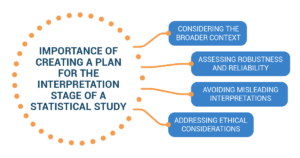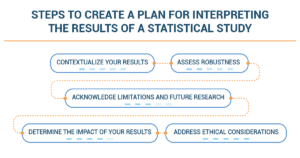Imagine this: You’re sitting in a movie theater, eagerly awaiting the start of a highly anticipated film. As the lights dim and the opening scene unfolds, you find yourself engrossed in the story, captivated by the characters and their journey. But imagine if, at the climax of the movie, the screen suddenly goes blank, leaving you bewildered and confused. The absence of a proper ending would leave you questioning, speculating, and desperately seeking closure.
Now, let’s pause and consider how this scenario relates to our everyday lives. We encounter situations where we crave clear explanations, reliable conclusions, and meaningful insights. Whether it’s making decisions based on a product review, interpreting the results of a scientific study, or understanding the implications of a news headline, we all seek understanding and clarity in the face of information overload.
As researchers, it is not enough to collect and analyze data; we must also have a plan for interpreting the results of our statistical study. Just as a movie needs a well-crafted ending to leave us satisfied, a statistical study requires careful planning to ensure the results are not left open-ended or misleading. The interpretation stage is crucial because it allows us to make sense of the data and draw meaningful conclusions.
Why Is it Important to Create a Plan for Interpreting Results
- Considering the broader context: By creating a plan, we ensure that our results are viewed within the larger literature, domain, and context of our topic of interest. This helps us understand how our findings contribute to existing knowledge and how they may impact the field.
- Assessing robustness and reliability: A clear plan enables us to assess the strength and reliability of our findings. We can determine if our results hold up under different conditions, consider potential confounding factors, and ensure that our conclusions are well-supported.
- Avoiding misleading interpretations: Having a plan helps us anticipate ways in which results could mislead us or our audience. It encourages critical thinking and helps us identify potential biases, limitations, and alternative explanations that need to be considered.
- Addressing ethical considerations: A plan allows us to anticipate potential ethical issues that may arise from the misuse of our study’s findings. By considering privacy concerns, conflicts of interest, and the responsible use of data, we can ensure that our research is conducted ethically and does not harm individuals or communities.
What Are the Steps for Developing the Plan
1. Contextualize your results: Find existing studies related to your topic of interest and consider how your findings fit into the larger domain, social, economic, or historical context. This will help you understand the significance of your results and their implications.
- Let’s say you conducted a survey to understand the impact of social media on teenagers’ mental health. To interpret your results, you would find existing studies on the topic to see how your findings fit into the larger research context on social media and mental health. This will help you understand if your results support or add new insights to the existing knowledge.
2. Assess robustness: Decide if you need to perform a sensitivity analysis to test the stability of your results. Anticipate confounding factors that might influence your findings and plan to address them. Consider reproducing your results using different statistical models and seek peer review to validate your findings.
- Suppose you conducted a survey to investigate the relationship between hours of sleep and performance ratings. To assess the robustness of your findings, you might perform a sensitivity analysis by comparing the results when considering different variables like work habits or extracurricular activities. This will help you determine if your initial findings hold true under different circumstances.
3. Acknowledge limitations and future research: Create a list of potential sources of bias and expected limitations of your study. Be clear about what questions your study is not meant to answer. This transparency helps to provide a realistic interpretation of your results and identifies areas for further investigation.
- Imagine you conducted a research project investigating the effects of music on productivity. In interpreting your results, you would create a list of potential sources of bias, such as individual preferences for specific music genres or the influence of external factors like noise levels. You would also acknowledge the limitations of your study, such as a small sample size or limited study duration. Additionally, you would identify questions that your study did not answer, such as the long-term effects of music on productivity.
4. Determine the impact of your results: If your results will drive decision-making, create a list of possible decisions that depend on the study’s outcome. If your research is intended for broader audiences, plan how to translate your results into non-technical language and highlight key takeaways and implications that are meaningful and accessible to these audiences.
- Suppose you conducted research on the benefits of office uniforms. If your results show that uniforms lead to better discipline and improved performance, you can create a list of possible decisions based on these findings, such as recommending the implementation of uniforms in offices or suggesting further studies to explore the effects on employee well-being.
5. Address ethical considerations: Anticipate privacy issues, conflicts of interest, or potential misuse of your study’s findings. Consider how you will handle and communicate these ethical considerations responsibly, ensuring the ethical use of data and the protection of individuals’ rights.
- Suppose you conducted a study on the effects of a new medication. You would need to anticipate privacy issues by ensuring that participants’ personal information remains confidential. You would also need to address potential conflicts of interest by disclosing any financial relationships with the pharmaceutical company producing the medication. This transparency ensures the ethical use of the study’s findings.
Crafting an Insightful Interpretation Plan for Pharmaceutical Research
In the dynamic realm of pharmaceuticals, Mark Davis, a seasoned corporate professional with a background in healthcare and business strategy, found himself at the helm of a pivotal project. His journey involved the meticulous creation of an interpretation plan for the results of a groundbreaking clinical trial, fusing his corporate expertise with his commitment to advancing healthcare.
Mark’s project centered around a groundbreaking clinical trial that aimed to assess the efficacy and safety of a novel pharmaceutical intervention. Recognizing the significance of translating data into actionable insights, he understood that a well-structured interpretation plan would be instrumental in driving informed decisions and shaping the future of patient care. Mark’s corporate background had instilled in him the value of organized and strategic planning. Drawing from his expertise, he meticulously outlined the steps that would guide the interpretation process, ensuring that the results were accurately understood, communicated, and leveraged.
The first step was to define the key objectives of the interpretation plan. Mark’s aim was not only to understand the statistical significance of the trial results but also to contextualize them within the broader healthcare landscape. He sought to discern the practical implications of the intervention’s effectiveness and safety. Applying his analytical skills, Mark thoroughly reviewed the clinical trial data. He ensured that he understood the study design, patient demographics, dosages, and any potential confounding variables. This step, reminiscent of his corporate approach to data analysis, ensured that he was equipped with a deep understanding of the dataset.
Recognizing the importance of clinical relevance, Mark planned to assess the clinical significance of the trial outcomes. Drawing from his experience in healthcare strategy, he devised criteria to evaluate whether the observed benefits of the intervention translated into meaningful improvements in patient outcomes and quality of life. Mark recognized that understanding statistical significance was crucial. He engaged with biostatisticians to gain insights into the p-values, confidence intervals, and effect sizes associated with the trial results. This corporate approach to data-driven decision-making ensured that he could accurately communicate the strength of the evidence.
Applying his corporate strategic thinking, Mark planned to translate the trial results into actionable recommendations. He aimed to provide healthcare practitioners with guidance on how the intervention could be integrated into clinical practice, considering factors like patient selection, dosing guidelines, and potential adverse effects. Ethics and regulations remained paramount in Mark’s planning process. He ensured that his interpretation adhered to ethical guidelines and was aligned with regulatory standards. His corporate professionalism translated into a commitment to presenting the results in an unbiased and transparent manner.
Mark leveraged his corporate network to seek input and feedback from experts in various fields, including clinicians, pharmacologists, and patient advocates. This collaborative approach ensured that his interpretation plan was robust and encompassed diverse perspectives. Armed with his meticulously crafted interpretation plan, Mark was ready to communicate the insights. He planned to create comprehensive reports that summarized the trial findings, implications, and recommendations. His corporate communication skills would ensure that the information was accessible and actionable for stakeholders.
As Mark executed his interpretation plan, the impact of his meticulous approach became evident. His case study exemplifies how a corporate professional’s strategic mindset can elevate the interpretation of complex research results. Through his commitment to precision and patient care, Mark’s journey underscores the art of designing an insightful interpretation plan that bridges the world of pharmaceutical research with the realm of corporate excellence.

